The mystery of Lot et Garonne & the Bastide towns
December 13th, 2017The prune orchard
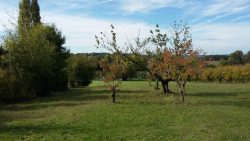
Lake & trees in St Maurice de Lestapel
The highest concentration of Bastide towns can be found in the French department Lot et Garonne in the region of Aquitaine in south west France. It is an area of undulating countryside which might be mistaken for parts of southern England except in France you have numerous vineyards, man made lakes and prune orchards. The lakes have been made to provide water for the prune trees. The dried prune is made by baking the fruit in the oven for 24 hours. Nowadays the lakes are also extensively used for fishing. In the middle of this region is a little village St Maurice de Lestapel (population about 110 people). This is where I am staying whilst I explore the mystery of the Bastide towns.
If you would like to stay in Airbnb please click here
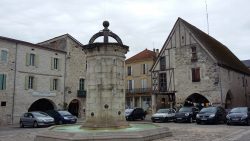
Eymet
The delights of Bastide towns
A Bastide town is usually constructed round an existing building such as a church or château. They were built by the English and the French in the 13th and 14th centuries and were fortified by gates and ramparts. The streets are laid out at right angles, converging on the main square and covered market. The central square served as a commercial hub and market place and provided a sense of order from which trade could prosper. This enabled the Lords who created them to collect additional taxes. They also usually have surrounding archways.
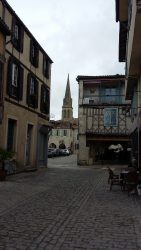
Eymet
These little towns remain remarkably untouched and are a delight to visit. Other recent visitors have gone one step further and have decided to permanently live here or have a second home. Typical is a retired history teacher from Sheffield living in Eymet, aged 84, who came out here in 1988 and has never returned. I find him playing chess outside the local bookshop and coffee shop. His opponent is also English and from Shropshire and he regularly commutes between England and France every 10 days and has a home overlooking the square in Eymet. The wife of the ex history teacher had died in 2007 but he had no desire to return to England. He reminisces about the brilliant footballer Tommy Lawton, who played for Notts County and England, when he hears I am from Nottingham and a Nottingham Forest supporter. He loves his glass of French red wine every day and a quiet smoke. Life is good and so much more relaxed than England and he usually wins the third game of chess.
Probably nearly half of the population of Eymet originate from outside France and a significant number of these are from the UK. Other nationalities attracted to the area include the Dutch, Belgian and Scandinavians. The largest concentration of Bastide towns in France is in Lot et Garonne with an estimated 47. There are said to be 500-700 Bastides in France depending on how you define the term.
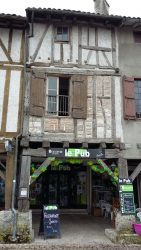
Eymet
The origin of the Bastide town may have come from a number of sources. The grid layout may have been inspired by the Roman ‘castrum’ (camp). The idea of central square may have come from the Islamic world via the crusaders or via moorish Spain. The main roads in the grid are known as carreyras, or carriage ways, since they are wide enough for carts. In the Lot et Garonne and surrounding area are some of the most interesting Bastides such as Eymet, Monpazier, Monflanquin and Villeréal.
As part of this blog I will take you on a tour of these atmospheric towns, surrounding châteaux and a myriad of markets. Whatever the origins of these Bastide towns there is no doubt their allure transcends nationalities and cultures. Whilst here I met Dutch, American, Canadian, Australian, Belgian, Scandinavian, Russian, Portuguese as well as British tourists and their compatriots who have decided to stay. Some are attracted by the sun, although it can be very cold in winter, but for most it is the unspoiled medieval towns that seemingly are unchanged from six centuries ago.
Would you like to be a house-sitter?

Roux
‘I have 14 cats and two dogs. Would you like to look after them?’ This is the reason why we find ourselves in the village of St Maurice de Lestapel. The owner of the cats, some of which are feral, and the two dogs has gone on holiday and she needs someone to look after them whilst she is away. Four of the cats are kittens and just a few weeks old and are keen to escape the garden and house but are unaware of the dangers of the main road running by the house. The kittens are charmingly named Roux, Zorro, Issi and McFee and they all have very distinctive characters. Whilst we are here they almost seem to grow from being children into becoming teenagers as they learn how to climb trees, escape onto the road and clamber onto the roof of the house.
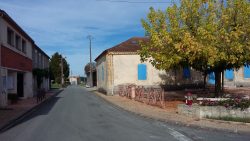
St Maurice de Lestapel
The nearest towns to St Maurice de Lestapel are Castillonnès, Cancon and Monbahus all less than 8kms away. Monbahus is host to a Portuguese restaurant which also provides the only bar that is open locally in the evening. There is, in fact, a sizeable local Portuguese population who come over doing jobs as builders such as fitting new windows in houses or working the farming equipment in the harvesting season. The restaurant can often be very noisy as the Portuguese work off excess energy from their working day and bring their young families along to enjoy the food. It is also very popular as it offers a limited but tasty menu. Starters are normally homemade soup followed by duck or pork or beef with chips and vegetables. There are a choice of desserts such as cheese and biscuits or fruit salad. Duck is a popular option also in the local French restaurants. The French, English as well as the Portuguese love it here as the service is welcoming and often better value for money than the local French restaurants. The meat served in the restaurant is actually brought over by van from Portugal.
A day trip to Monflanquin
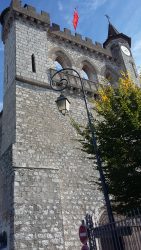
St Stephen’s Church, Monflanquin
Monflanquin is 17km north of Villeneuve-sur-Lot and is an English fortified Bastide town built in the 13th century and it features St Stephen’s church. Despite being situated on a steep slope, it conforms to the regular pattern of right angled streets leading from a central square to the four town gates. The ramparts were destroyed in 1630 but otherwise Monflanquin has experienced few radical changes since the 13th century.
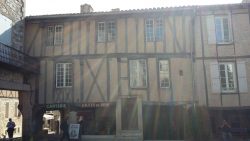
Monflanquin
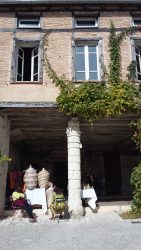
Monflanquin
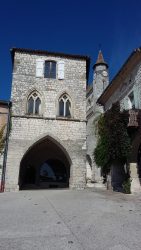
Entrance gate at Monflanquin
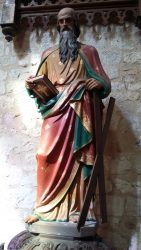
Statue of St Stephen, Monflanquin
St Stephen – a martyr stoned to death
I was surprised to learn on visiting the inside of St Stephen’s church that St Stephen was the first Christian martyr. He was believed to have been a Greek Jew who converted to Christianity. His oratory was so effective that many Jews became worried about his success. He was accused of blasphemy and he was made to stand trial. Following his trial, where he was found guilty, he was dragged out onto the streets and stoned to death. This was an event witnessed by St Paul in about 34AD. Interestingly he is the patron saint of deacons, headaches, horses, coffin makers and masons (source BBC religions). So next time you have a headache think of St Stephen. I suspect not many people today are aware of the significance of St Stephen.
St Maurice de Lestapel
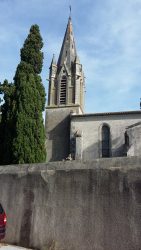
Village church, St Maurice de Lestapel
St Maurice de Lestapel, I suspect, is typical of hundreds of other small villages in France but still has a very special charm of its own. Our morning routine is to take the two dogs Max and Kiki for a walk around the local lake set in the middle of the local plum orchards. Max, a Belgian Shepherd Cross rescue dog, loves not only to run around the lake but also finds any excuse to jump into the water and have a swim. The lake is only a few hundred yards away from where we are staying and is a beautiful spot in the early evening as the sun lowers in the sky. It is enjoyed by dog walkers and anglers who pay a small fee for a licence to fish here. Strangely very few of the local French take their dogs for a walk around the lake.

Max
The village has a local mayor who has an important role in giving leadership to the local community and sorting out disputes. For example, there is an annual day of cleaning in the village when all local residents come together to help ‘spruce’ up the place. Most villagers take part. There is no door to door collection of your rubbish but instead you take your rubbish to a communal point behind the church and you are expected to sort out recyclable materials from other rubbish. Again residents willingly do this. Would this happen in England? I am not so sure. The current point for lively discussion in the village is the compulsory installation of sewage drains connection to all houses. This will significantly increase water bills and in addition all householders will have to contribute to the construction costs. Currently homes in the village are linked to their own septic tanks which seems to work well but the upgrading of sewage drains is a nationwide edict.
The Times They Are A-Changin’
The lyrics to the Bob Dylan song ‘The Times Are Changin” famously start with the words:
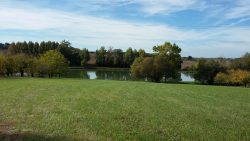
The lake, St Maurice de Lestapel
‘Come gather around people
Wherever you roam
And admit that the waters
around you have grown’.
We are increasingly told that we live in a unique time when the pace of change is significantly greater than previous times. The impact of the internet and globalization is bringing a sense of uncertainty into our lives. But I am not so sure. Part of the attraction of living in a place like St Maurice de Lestapel is that the pace of change in the world does not seem as fast as we find in our urban environments. I love the Bob Dylan song written in 1964. Is it a sense of nostalgia for my youth or is it the brilliance of the lyrics capturing all of our inner insecurities? Change impacts on this village as much as anywhere else. How do young people living here find work and, for example, can the local dairy farm sustain a viable living from farming today and can the old cope with the frailty of their bodies? The same challenges face the inhabitants of villages all over Europe and many other parts of the world. But is the change anymore significant than for previous generations?
How to survive & prosper
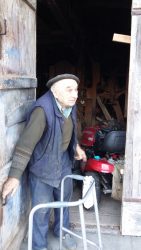
Mr Bouyne
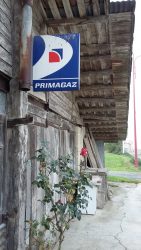
Calor gas for sale
Mr Bouyne is aged 91, the same age as my mum. Somehow he has managed to survive to this veritable age. He is the original owner of the house we are staying in and now lives in a house a few hundred yards up the road backing onto an orchard and local lake. He started work in the atomic energy business but had been made redundant. He had used his redundancy money to buy some equipment and undertaken work such as coffin making and selling calor gas cylinders. His wife now lives in a care home in nearby Castillonnès and he is able to visit her once a week. He needs a walking frame to get around but happily still gets on his motorized lawn mower to cut the grass and prepares and cooks all his own meals, often using ingredients grown in his garden such as mushrooms, tomatoes and apples. His eyesight is good enough to read the local newspaper and he takes a keen interest in national politics and news. We visit every evening to feed his feral cat and chat about how the day has gone. Are the changes he has managed in his life any less challenging than for subsequent generations?
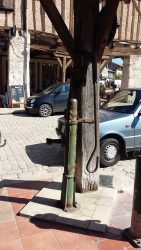
Water pump, Villeréal
Villeréal in October
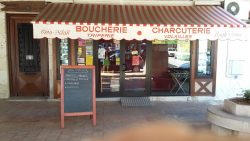
Villeréal
We are sitting outside a cafe drinking coffee overlooking the market square of Villeréal (12km from Castillonnès) in the middle of October. Temperatures are in their early twenty degrees centigrade, so we relax in the sunshine knowing it will be much colder in England. Villeréal is an active town throughout the year and not just in the summer when the tourists are around. The local shops are busy at all times of the year which is not the case in many local towns which struggle to survive economically when the tourists are absent. Fellow customers are a number of Englishmen, who live locally, and are drinking beer and wine, and two Dutch men. Most of the men have lived here for a number of years and occasionally return to England to visit family and friends. None seem to regret re-locating.
I am not sure if the water pump situated in the market square is working. However whilst we are seated at the cafe two people try out the pump but no water emerges into their buckets. Perhaps the water level is just too low this particular day.
Monpazier above the River Dropt
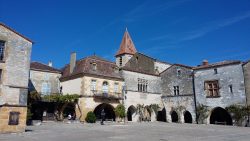
Monpazier
We travel just a further 12 km from Villeréal to the town of Monpazier (24km from Castillonnès) a picturesque Bastide town located just above the River Dropt, founded in 1284 by King Edward I of England on land granted by Pierre de Gontaut-Biron . It has a central square, which seemingly has remained intact despite hundreds of years of conflict in the town such as the peasant revolts in 1637 (source The Rough Guide to The Dordogne & Lot). Three of its six medieval gates are also still intact.
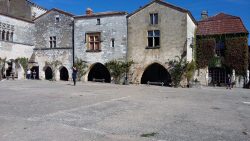
Monpazier
It has time worn stone built houses, with none looking quite the same. There are also shady arcades between the houses which no doubt brings some relief from the heat in the height of the summer. In the summer time there are a number of art exhibitions and medieval festivals to entertain the tourists
How to make a living
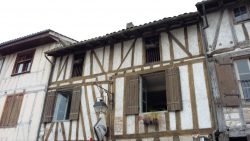
Eymet
I am chatting to the English owner of a bookshop and coffee place in Eymet. It is a sunny afternoon in mid October and there are a few tourists walking around admiring the medieval square. However he tells me that the number of English visitors had declined by about 50% in the past 3 years, the fall in the value of sterling against the Euro probably being a major factor to cause this decline in tourism. There had been an increase in the number of German and Belgian visitors to compensate partly for this. He explains how he had previously lived in the Vendée area and in Perigueux. He had originally earned his living in France by running a mobile fish and chip van and as a joint proprietor with his wife of an Indian restaurant. Unfortunately his wife suffered from shingles and they had to close the restaurant.
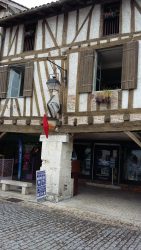
Eymet
More recently he had separated from his wife and fallen over when taking his dogs for a walk. This had resulted in a broken hip from which he still suffered from the pain and his mobility was restricted. These tales of woe were not helped by what he perceived as a bureaucratic French tax system. As well as paying income tax he also had to pay a ‘social tax’ which was based not on his net earnings but total turnover. From his net income he just about made enough to pay his bills but no longer was able to run a car.
Another English woman I met living in St Maurice de Lestapel earned her living by catering for wedding parties looking after young children for working parents and working as part of a team of cleaners for holiday gites. She had integrated well into the local French community and from her portfolio work made a comfortable living, although she did not have a mortgage or rent to pay. One of the attractions of living in the Lot et Garonne is the relatively low cost of housing but work, other than tourism, is not easy to find.
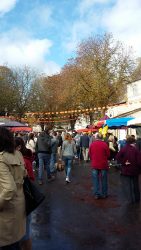
Issigeac market
Issigeac market
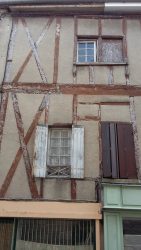
Issigeac
There are 35 open air weekly markets within an hour’s drive of St Maurice de Lestapel. Probably the most popular is the Issigeac market. Issigeac is a medieval Bastide town about 10kms north of Castillonnès and holds its market on a Sunday. Markets are not just a place to buy fresh food but also a source of friendship where local people, including many English, have a cup of coffee or glass of wine and share their news with friends and family. It is not too strong a statement to say the French market is an institution and a major factor in binding French society together. Somehow your spirits are raised as you see the array of food on display and taste the fruit, vegetables, sausages and cheeses. The French don’t just eat food. They celebrate it. There is much more variety of food than can be found in the local supermarket.
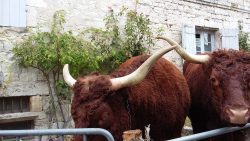
Issigeac market
We are eating tea and cake in a posh tea shop in Issigeac, called ‘Le Shabby Chic Corner’, but to my surprise at our feet are the two dogs Max and Kiki. This is unlikely to be the case in England where pets would often be discouraged from coming inside but in France dogs are a part of the family and the other customers are comfortable with the dogs lying on the floor next to their table. The exception to this are farm dogs which are often seen as farm animals rather than pets. This is a friendly but stylish tea room which is always packed with people. On a previous visit we had sat opposite a retired American couple who were staying in Monpazier and had previously visited France when based at an American naval base in Morocco. They loved French life and culture as do so many other American visitors to France.
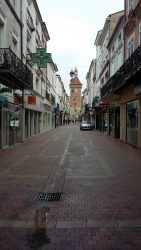
Villeneuve sur Lot
On the way to Pujols via Villeneuve-sur-Lot
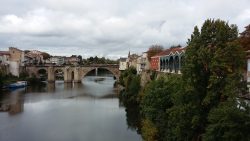
River Lot
Villeneuve-sur-Lot is a working town rather than a major tourist attraction but is a useful stopping off point before visiting the medieval town of Pujols. Villeneuve-sur-Lot is about 30kms south of Castillonnès and is based on the banks of the River Lot. It is a pleasant place to stop for a coffee or have a bite to eat and enjoy the view from the bridges crossing the river. Pujols is on the outskirts of the town on top of a hill about 3 kms from the town centre but be careful following the signs to Pujols as some roads lead to the suburb of Pujols which is different from the medieval town. It is easy to take a wrong turning as we managed to do.
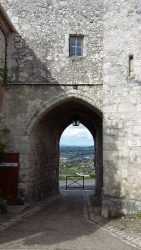
Pujols
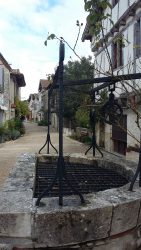
Pujols
Pujols is well worth a visit and there are good parking facilities. Just wander around the picturesque old town and admire the medieval buildings. It is a walled village with fine views across open countryside and the River Lot. The entrance to the village is via an impressive archway which leads to the main square and St Nicholas’ Church. Whilst we are there an exhibition of art and textiles is on display in the church. It is relaxing to see the work of local artists and it reminds me of a similar exhibition in Snettisham in Norfolk, England which I had visited earlier in the year. Both are hosted by volunteers and there is a real sense of community. The art works on display are very similar in style which I find surprising but somehow equally charming.
Festival of St Maurice
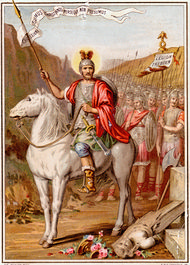
St Maurice & the Theban Legion
Fifty two towns and villages in France have been named in honour of St Maurice. Representatives of these towns gather together every year to celebrate the origin of the name of their town and this is called the Festival of St Maurice. This has recently been held in St Maurice de Lestapel when there was a celebration in the form of dancing, music and eating. Other towns outside of France from countries such as St-Maurice in Switzerland also joined in the celebrations.
Legend has it that St Maurice was an Egyptian, born in Thebes. He became the commander of the legendary Roman Theban Legion in the 3rd century. However when the Roman leader Maximian ordered the Theban Legion to harass local Christians Maurice refused. Maximian then ordered every tenth soldier to be killed as punishment. Despite this action Maurice refused to allow his Theban Legion to be involved with the harassment and all of the remaining members of the Legion were executed. The place where this martyrdom took place is now known as St Maurice, Switzerland, site of the Abbey of St Maurice (Wikipedia).
When I was visiting Mr Bouyne in the village of St Maurice de Lestapel a friend of his was visiting and he shared a booklet he had compiled of the Festival of St Maurice. This is still in draft form but the pride he had taken in researching the origin and history of the St Maurice towns and villages shone through the research and pictures displayed. These traditions cannot be underestimated and can be found throughout the world. In terms of ‘economics’ they are of limited value but in terms of ‘social’ value they are very significant. However we still seem to struggle to acknowledge how important they are to the health and strength of local communities.
The perils of translating French
When we were staying in St Maurice de Lestepal our host shared a story of the challenge of learning French which the local people can understand. She had been told by her French language teacher to practice a sentence with someone every day. So when she was walking through the town of Monbahus near to the hill with a statue of the Virgin Mary on the top, she stopped to talk to an old man. She complimented him on how magnificent the Virgin Mary was but confused the word ‘Vierge’ with ‘Verge’, the French word for penis. The man looked down at his trousers and quickly walked away. It was only later she realized her mistake!
Places near Castillonnès
I hope you have enjoyed my tour of the towns and places in Lot et Garonne and the people who live in this area. If you have visited Lot et Garonne or live here please add your own comments. A further travel blog is due to be published in the near future which features the chateaux in the region. Please find below a mini map which I have drawn to give an idea of the distances between the towns.
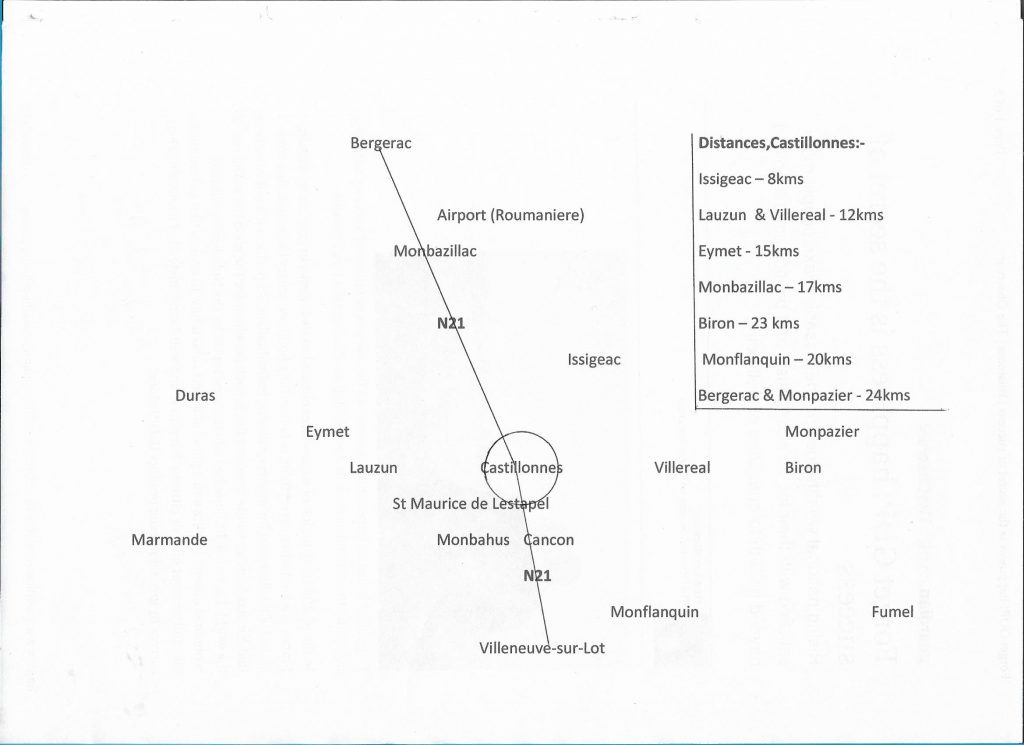
Places near Castillonnès


Comments
Hi Paul what a lovely blog, well done. Just a couple of things:
I think the photo of the market place is Villereal, not Monpazier.
The St Maurice rassemblement is every year not every 2 years.
I was surprised to learn that M Bouyne worked in atomic energy! To my knowledge he worked with wood all his life.
Love to you both.
Ann xxx
Ann
December 14th, 2017